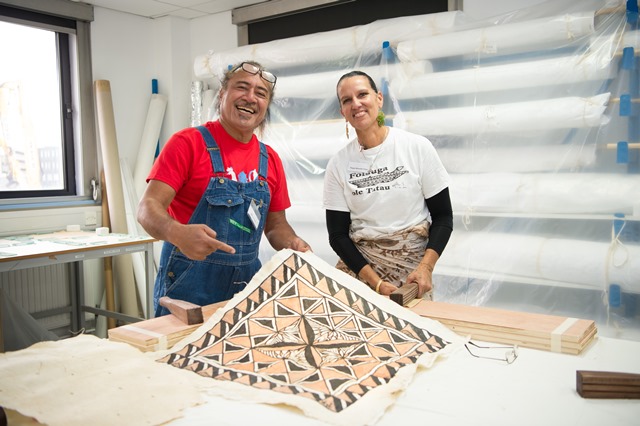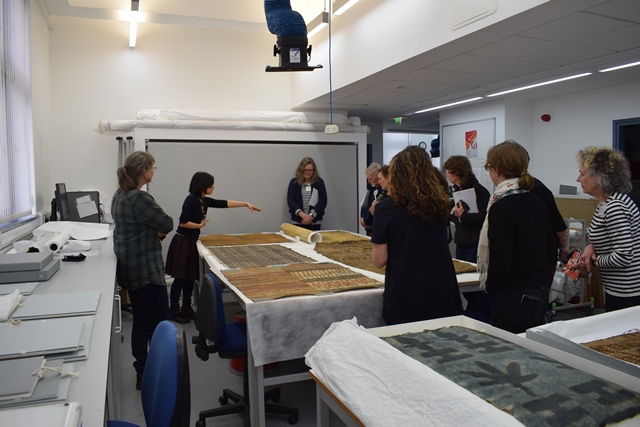UofG barkcloth workshop led by visiting American Samoans
Published: 19 April 2018
Leading Pacific barkcloth experts hosted a conservation workshop at the University of Glasgow for staff, students and conservators.

Leading Pacific barkcloth experts hosted a conservation workshop at the University of Glasgow for staff, students and conservators.
UofG’s barkcloth project team welcomed two American Samoan practitioners to Glasgow – Professor Reggie Meredith Fitiao from the American Samoa Community College and Uilisone Fitiao, a contemporary artist and teacher.
The barkcloth experts joined a three day workshop for museum conservators from the UK and the Netherlands to share knowledge of the conservation of Pacific barkcloth. The workshop was led by the project’s Research Conservator, Misa Tamura.
Those who took part also gained experience of making and decorating the traditional barkcloth of Samoa – siapo.
UofG’s Professor Frances Lennard, the Principal Investigator for the £1m Arts and Humanities Research Council funded project to shed light on Pacific barkcloth, said: “We were delighted to welcome Reggie Meredith Fitiao and Uilisone Fitiao to the University to work with us.
“While project staff have visited the Pacific and talked to barkcloth makers and enthusiasts there, it was also really valuable for the exchange to happen in the opposite direction.
“We benefited enormously from learning from Reggie about the making skills which have been handed down from one generation to another in Samoa, and from finding out more about the traditional designs for siapo from Uilisone.”
Alongside the conservation workshop, the core UofG research team, groups of textile conservation students and research colleagues also got the opportunity to make barkcloth for themselves. They also were able to experiment with different methods of decoration under the guidance of Reggie and Uilisone.
Professor Lennard from the Centre for Textile Conservation and Technical Art History in the School of Culture & Creative Arts, added: “This hands-on method of learning is absolutely invaluable in improving researchers’ and conservators’ understanding of barkcloth and can be of great help in understanding the way historic cloths were made, as well as contributing to decisions about the best methods to use when choosing conservation treatments.”
Until the 20th century, barkcloth was a vital material in the social, cultural and ritual lives of Pacific islanders. Sheets of the inner bark of trees were stripped and softened by soaking, then beaten with wooden mallets to stretch the cloth and to make it softer and stronger, before being decorated with painted designs.
The University of Glasgow’s Hunterian Museum has one of the world’s most significant collections of Pacific barkcloth, including some gathered during the first voyage of Captain Cook.
The AHRC-funded project called Situating Pacific Barkcloth in Time and Place aims to transform our understanding of Pacific barkcloth through research into historical, cultural and material aspects of artefacts held in important collections in the US and Britain.

Topics at the UofG workshop included an introduction to the way barkcloth is made and its regional diversity, and an introduction from Research Associate Dr Margaret Smith on her research into the analysis of barkcloth fibres, dyes and pigments.
Practical sessions were an important part of the workshop, giving participants the opportunity to try out treatments on modern barkcloth samples, including cleaning, humidification and structural repairs.
The chance to make their own small samples of barkcloth with Reggie and Uilisone was an added bonus for the conservators.
Professor Lennard said: “We’re also very pleased that the workshops have produced two larger pieces, decorated with traditional Samoan designs, which are tangible outcomes of the project.
“With many thanks to everyone involved, particularly Reggie Meredith Fitiao, Uilisone Fitiao, Misa Tamura, Dr Margaret Smith, our student volunteers who helped with the workshop: Eva-Maria Catic, Staphany Chang, Megan Creamer and Kim Tourret, and to the workshop delegates for their input.”
First published: 19 April 2018
Find out more
- Professor Franes Lennard - Research Profile
- School of Culture & Creative Arts
- Kelvin Centre for Conservation and Cultural Heritage Research
- Tapa: Situating Pacific Barkcloth in Time and Place

